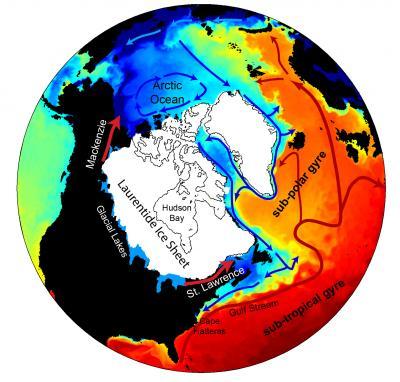It's a debate that has gone on for decades but new, high-resolution global ocean circulation models claim to have an answer/ The researchers report that the flood must have flowed north into the Arctic first down the Mackenzie River valley. They also say that if it had flowed east into the St. Lawrence River valley, Earth's climate would have remained relatively unchanged.
Events leading up to the sharp climate-cooling period known as the Younger Dryas, colloquially known as the "Big Freeze," unfolded after glacial Lake Agassiz, at the southern edge of the Laurentide ice sheet covering Hudson Bay and much of the Canadian Arctic, catastrophically broke through an ice dam and dumped thousands of cubic kilometers of fresh water into the ocean in a short time.
This massive influx of frigid fresh water injected over the surface of the ocean is assumed to have halted the sinking of very dense, saltier, colder water in the North Atlantic that drives the large-scale ocean circulation, the thermohaline circulation, that transports heat to Europe and North America. The weakening of this circulation caused by the flood resulted in the dramatic cooling of North America and Europe.

A new model of flood waters from melting of the Laurentide Ice Sheet and large glacial lakes along its edge that covered much of North America from the Arctic south to New England over 13,000 years ago, shows the meltwater flowed northwest into the Arctic first. This weakened deep ocean circulation and led to Earths last major cold period. A new model of flood waters from melting of the Laurentide Ice Sheet and large glacial lakes along its edge that covered much of North America from the Arctic south to New England over 13,000 years ago, shows the meltwater flowed northwest into the Arctic first. This weakened deep ocean circulation and led to Earths last major cold period. Credit: Alan Condron, UMass Amherst
"This episode was the last time the Earth underwent a major cooling, so understanding exactly what caused it is very important for understanding how our modern-day climate might change in the future," University of Massachusetts Amherst geoscientist Alan Condron said in their statement.
They say their global, ocean-ice circulation model is 10 to 20 times more powerful than previously attainable, and it allowed them to compare how meltwater from the two different drainage outlets was delivered to the sinking regions in the North Atlantic. They found the original hypothesis proposed in 1989 by Wally Broecker of Columbia University suggesting that Lake Aggasiz drained into the North Atlantic down the St. Lawrence River would have weakened the thermohaline circulation by less than 15 percent.
Condron and Winsor say this level of weakening is unlikely to have accounted for the 1,000-year cold climate event that followed the meltwater flood. Meltwater from the St. Lawrence River actually ends up almost 1,900 miles (3,000 km) south of the deep water formation regions, too far south to have any significant impact on the sinking of surface waters, which explains why the impact on the thermohaline circulation is so minor.
By contrast, their model says that when the meltwater first drains into the Arctic Ocean, narrow coastal boundary currents can efficiently deliver it to the deep water formation regions of the sub-polar north Atlantic, weakening the thermohaline circulation by more than 30 percent. They conclude that this scenario, showing meltwater discharged first into the Arctic rather than down the St. Lawrence valley, is "more likely to have triggered the Younger Dryas cooling."
Condron adds, "Our results are particularly relevant for how we model the melting of the Greenland and Antarctic Ice sheets now and in the future. It is apparent from our results that climate scientists are artificially introducing fresh water into their models over large parts of the ocean that freshwater would never have reached. In addition, our work points to the Arctic as a primary trigger for climate change. This is especially relevant considering the rapid changes that have been occurring in this region in the last 10 years."
Published in Proceedings of the National Academy of Sciences.





Comments